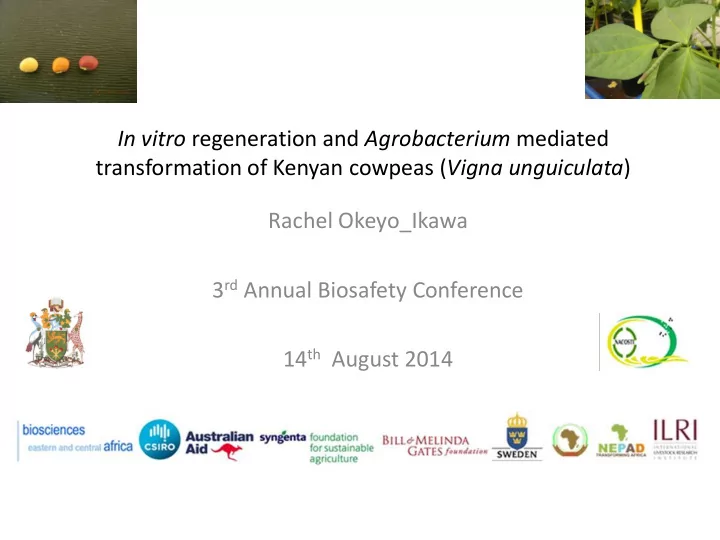

In vitro regeneration and Agrobacterium mediated transformation of Kenyan cowpeas ( Vigna unguiculata ) Rachel Okeyo_Ikawa 3 rd Annual Biosafety Conference 14 th August 2014
Introduction Cowpeas (Kunde) – grown for seeds, leaves and pods. Av. Production: Kenya – 0.3T / Ha, USA – 1.9T / Ha (USDA 2010) . Eastern province – 90% of national production
Cow pea production constraints Diseases (cowpea mosaic virus) Source: apsnet.org Drought Source:cherthollowfarm.com Bruchids Maruca Source: storedgrain.com.au Source: iita.org
Brief background on transformation Mode of action of Agrobacterium tumefaciens Source: Nepadbiosafety.net • Bacterial DNA is transferred to plant chromosome causing crown gall disease Crown gall disease Source: wiki.bugwood.org
Justification There is need to improve yields on existing cowpea varieties by enhancing tolerance to drought, diseases and insects / pests. To accomplish this via transformation, an efficient plant regeneration and transformation protocol needs to be established.
Objectives Main Objective To establish an efficient tissue culture regeneration and transformation protocol for Kenyan cowpeas. Specific objectives i. To establish a tissue culture regeneration protocol with various auxins and cytokinins. ii. Transformation of cowpea cotyledonary nodes with different strains of agrobacterium tumefaciens harboring the GUS reporter gene and nptll selectable marker gene. iii. To confirm the transfer and expression of the reporter gene by GUS histochemical staining.
Methodology Tissue culture Transformation optimization (GUS) Seed varieties Agrobacterium strains EHA105 & LBA4404 M66, K80 and KVU 271 Inoculation and co- Shoot initiation media with cultivation with BAP at 0, 0.2, 0.5 and 1 mg/l acetosyringone Rooting media with Selection on Kanamycin at 250mg/l IBA at 0, 0.2, 0.5 and 1 mg GUS histochemical staining Acclimatization and potting in and PCR with nptll primers screen house
Results – cont’d Plasmid Map for pCAMBIA 2301 Source: www.snapgene.com
Results Direct organogenesis from cotyledonary node explants 4wks Shoot initiation Cotyledonary node Germination explants – 1mg/l BAP 3wks 3wks Shoot elongation 0 PGR, rooting 0.5mg/l IBA Flowering plants after 8 Acclimatization weeks in soil in coco peat
Results – cont’d Effect of BAP on shoot initiation in 3 cowpea varieties after 4 weeks of culture in MSB5 medium. No. of shoots per explant 3.0 2.8 2.7 2.6 2.5 2.5 2.3 2.2 2.0 1.8 1.8 1.6 1.6 1.5 1.5 1.2 1.0 0.5 0.0 0 0.2 0.5 1.0 BAP Concentration (mg/l) K80 KVU-271 M66
Results – cont’d Effect of IBA on root length of 3 cowpea varieties after 3 weeks in culture 9.0 8.0 8.0 7.0 7.0 6.6 Root length (cm) 6.0 5.6 4.8 5.0 4.7 4.4 4.4 4.2 3.9 4.0 3.5 3.4 3.4 3.4 2.9 2.8 3.0 2.4 2.0 1.0 1.0 0.0 0 0.2 0.5 1.0 MSO 0.5MSO IBA concentration (mg/l) K80 KVU-271 M66
Results – cont’d Regeneration of transformed plants in medium containing kanamycin at 250mg/l Cotyledonary nodes Elongated shoots after 8 weeks Shoot initiation after 2 weeks in selection medium in selection media
Results – cont’d • Regeneration frequency after 2 weeks in selection medium with 250mg/l kanamycin Acetosyringone Inoculation Days of co- Average conc. (µM) time cultivation regeneration (%) 100 30 mins 3 74.07 100 1 hr 3 91.07 100 30 mins 4 100.00 100 1 hr 4 66.81 200 30 mins 3 100.00 200 1 hr 3 81.90 200 30 mins 4 93.75 200 1 hr 4 45.60 • Best regeneration with 200µM acetosyringone, 30 minutes inoculation and 3 days co-cultivation
Results – cont’d Effect of Agrobacterium strain on regeneration after 2 weeks on selection medium B A LBA4404 with pCAMBIA 1301 EHA105 with pCAMBIA 1301
Results – cont’d Transient GUS assay with x-gluc Transformation frequency ≥ 90% A. Cotyledonary nodes after 3 days Co-cultivation Transformation frequency 17% B. Leaves from plants after 4 weeks in selection media with 250mg/l kanamycin expressing GUS gene.
Results – cont’d PCR of leaves after 8 weeks in selection medium with NPTll primers 1kb+ NT T1 T2 T3 P – Thermo cycler conditions 95 0 C – 3 min 95 0 C – 45s 600bp 35 cycles 62 0 C – 45s 72 0 C – 2.5 min 72 0 C – 10 min NT = Non-transformed plant, T = Transformed sample, P = Plasmid DNA (+ve control), – = Water (-ve control) • PCR analysis on 2 of the 3 plants sampled showed presence of nptll gene – there are chances of escapes.
Conclusion • The 3 varieties of cowpeas responded differently to growth hormones. • Variety M66 had the highest number of shoots per explant on 0.5mg/l BAP, while KVU 271 had the best rooting response in ½ strength MS with no growth regulators. • A. tumefaciens strain EHA105 was more effective in transformation in comparison to LBA4404 • Successful transformation protocol can be used to introduce desirable agronomic traits e.g. those that confer drought or disease resistance into Kenyan cowpeas.
Acknowledgements • The BecA – ILRI hub • NACOSTI • The University of Nairobi • Supervisors – Dr. Amugune, Dr. Njoroge (UoN), Dr. Holton, Dr. Skilton (BecA) • IITA , CIP and KARI
Recommend
More recommend